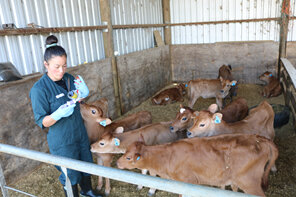
Disbudding should occur two to six weeks of age, to allow easier handling, reduced stress and minimal tissue damage, as the horn bud is free-floating in the skin over the skull at this age. As the calf grows, the horn bud attaches to the skull, and a small horn forms. Dehorning after the horn attaches to the skull increases the chance of significant pain and infection, with calves also harder to handle.
Best practice disbudding involves:
Sedation
Sedation temporarily reduces the level of consciousness, preventing calves’ perception of pain, providing relaxation and reducing risk of injury to both calves and handlers. To administer local anaesthetic and safely disbud calves, sedation is preferable over physical restraint.
Pain relief
Pain relief MUST be used when disbudding, as per Animal Welfare (Care and Procedures) Regulations 2020, Section 57 (Refer below for more info). Failure to do so can result in prosecution and fines.
Anaesthetics (loss of sensation) and analgesics (pain relief) target different pain pathways, and can be used individually or together.
Anaesthetic works fast, numbing the horn bud and surrounding tissues for about two hours, ideal for during the procedure.
Pain relief injected into the neck, provides longer term relief, benefiting in:
Metacam is an injectable non-steroidal anti-inflammatory drug (NSAID) that targets inflammation that causes pain. It has anti-inflammatory (reduces inflammation), analgesic (pain killer) and anti-pyretic (reduces fever) properties.
Animal Welfare (Care and Procedures) Amendment Regulations 2020 came into effect 9 May 2021 in respect of calf disbudding. The amended regulations state:
Restricted Veterinary Medicine. Available only under Veterinary Authorisation. ACVM No’.s A7550